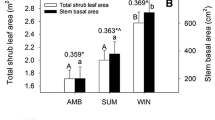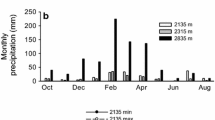Summary
Chaparral shrubs of California have a suite of morphological and physiological adaptations to withstand the prolonged summer droughts of a mediterranean climate. Not all species of chaparral have the same rooting depth and there is some evidence that those with shallow roots have tissue that is most tolerant to water stress. We tested this notion by comparing the tissue water relations of four co-occurring chaparral shrubs: Quercus durata, Heteromeles arbutifolia, Adenostoma fasciculatum, and Rhamnus californica. We used a pressure-volume technique and a dew-point hygrometer to metsure seasonal changes in osmotic potential when plant tissue was fully hydrated and osmotic potential at predawn, midday, and the turgor loss point. We also calculated seasonal changes in the minimum daily turgor potential, saturated weight/dry weight ratio of leaf tissue, and the bulk modulus of elasticity. We had information on the seasonal water use patterns and apparent rooting depths of these same four shrubs from a previous study (Davis and Mooney 1986). All evidence indicated that Rhamnus had shallow roots and Quercus deep roots. Our results indicated that the tissue water relations of our four co-occurring chaparral shrubs were not alike. Even though Rhamnus had shallow roots, it had the least xerophytic tissue. Seasonal osmotic potential and saturated weight/dry weight ratios were relatively high and bulk modulus of elasticity and minimum daily turgor potentials were low. Furthermore, even though Quercus had deep roots and experienced no seasonal water stress at our study site, its tissue water relations indicated relatively high tolerance to water stress. We conclude that seasonal drought tolerance of stem and leaf tissue of co-occurring chaparral shrubs does not necessarily correspond to rooting depth, to soil moisture resources available to the shrub, or to the degree of seasonal water stress experienced by the shrub.
Similar content being viewed by others
References
Barnes FT (1979) Water relations of four species of Ceanothus. MA thesis, San Jose State University, CA, p 44
Bowman WD, Roberts SW (1985) Seasonal and diurnal water relations adjustments in three evergreen chaparral shrubs. Ecology 66:738–742
Calkin HW, Pearcy RW (1984) Seasonal progressions of tissue and cell water relations parameters in evergreen and deciduous perennials. Plant, Cell and Environ 7:347–352
Campbell GS, Papendick RI, Rabie E, Shayo-Ngowi AJ (1979) A comparison of osmotic potential, elastic modulus, and apopolastic water in leaves of dry-land winter wheat. Agron J 7:31–36
Cheung YNS, Tyree MT, Dainty J (1975) Water relations parameters on single leaves obtained in a pressure bomb and some ecological interpretations. Can J Bot 53:1342–1346
Cheung YNS, Tyree MT, Dainty J (1976) Some possible sources of error in determining bulk elastic moduli and other parameters from pressure-volume curves of shoots and leaves. Can J Bot 54:758–765
Cody ML, Mooney HA (1978) Convergence versus nonconvergence in mediterranean-climate ecosystems. Ann Rev Ecol Syst 9:265–321
Cooper WS (1922) The broad sclerophyll vegetation of California. Carnegie Inst Wash Pub, p 122
Davis SD, Mooney HA (1985) Comparative water relations of adjacent California shrub and grassland communities. Oecologia (Berlin) 66:522–529
Davis SD, Mooney HA (1986) Water use patterns of four cooccurring chaparral shrubs. Oecologia (Berlin) (in press)
Dunn EL, Shropshire FM, Song LC, Mooney HA (1976) The water factor and convergent evolution in mediterranean-type vegetation. In: Lange OI, Kappen L, Schulze ED (ed) Water and plant life. Springer, Berlin Heidelberg New York, pp 492–505
Hinckley TM, Duhme F, Hinckley AR, Richter H (1980) Water relations of drought hardy shrubs: osmotic potential and stomatal reactivity. Plant, Cell and Environ 3:131–140
Krause D, Kummerow J (1977) Xeromorphic structure and soil moisture in the chaparral. Oecol Plant 12:133–148
Kummerow J (1973) Comparative anatomy of schlerophylls of mediterranean climate areas. In: Castri F di, Mooney HA (ed) Mediterranian type ecosystems: origin and structure. Springer, Berlin Heidelberg New York, pp 157–167
Kummerow J, Krause D, Jow W (1977) Root systems of chaparral shrubs. Oecologia 29:163–177
Meinzer F, Seymour V, Goldstein G (1983) Water balance in developing leaves of four tropical savanna woody species. Oecologia (Berlin) 60:237–243
Miller PC, Poole DK (1979) Patterns of water use by shrubs in southern California. Forest Sci 25:84–98
Munz PA (1974) A flora of southern California. Univ Calif Press, Berkeley, p 1086
Nilsen ET, Sharifi MR, Rundel PW (1983) Diurnal and seasonal water relations of the desert phreatophyte Prosopis glandulosa (honey mesquite) in the Sonoran Desert of California. Ecology 64:1381–1393
Nobs MA (1963) Experimental studies on species relationships in Ceanothus. Carnegie Inst Wash, p 623
Parsons DJ (1976) Vegetation structure in mediterranean scrub communities of California and Chile. J Ecology 64:435–447
Parsons DJ, Rundel PW, Hedlund RP, Baker GA (1981) Survival of severe drought by a non-sprouting chaparral shrub. Amer J Bot 68:973–979
Poole DK, Miller PC (1975) Water relations of selected species of chaparral and coastal sage communities. Ecology 56:1118–1128
Poole DK, Miller PC (1978) Water related characteristics of some evergreen sclerophyll shrubs in central Chile. Oecol Plant 13:289–299
Ritchie GA, Roden JR (1985) Comparison between two methods of generating pressure-volume curves. Plant J Cell Environ 8:49–53
Roberts SW, Strain BR, Knoerr KR (1980) Seasonal patterns of leaf water relations in four co-occurring forest tree species: parameters from pressure-volume curves. Oecologia (Berlin) 46:330–337
Roberts SW, Strain BR, Kneorr KR (1981) Seasonal variation of leaf tissue elasticity in four forest tree species. Physiol Plant 52:245–250
Schimper AFW (1903) Plant geography on a physiological basis. (Transl. by Fisher WR), Claredon Press, Oxford, p 839
Turner NC, Jones MM (1980) Turgor maintenance by osmotic adjustment: a review and evaluation. In: Turner NC, Kramer PJ (ed) Adaptation of plants to water and high temperature stress. John Wiley and Sons, New York, p 482
Tyree MT, Hammel HT (1972) The measurement of the turgor pressure and the water relations of plants by the pressure-bomb technique. J Exp Bot 23:267–282
Tyree MT, Jarvis PG (1982) Water in tissues and cells. In: Lange OL, Nobel PS, Osmond CB, Ziegler H (ed) Physiological plant ecology II water relations and carbon assimilation. Springer, Berlin Heidelberg New York, pp 35–77
Tyree MT, Cheung YNS, MacGregor ME, Talbot AJB (1978) The characteristics of seasonal and ontogenetic changes in the tissue-water relations of Acer, Populus, Tsuga, and Picea. Can J Bot 56:635–647
Wenkert W (1980) Measurement of tissue osmotic pressure. Plant Physiol 65:614–617
Wenkert W, Lemon ER, Sinclair TR (1978) Water content-potential relationship in soya bean: changes in component potentials for mature and immature leaves under field conditions. Ann Bot 42:295–307
Wilson JR, Ludlow MM (1983) Time trends for change in osmotic adjustment and water relations of leaves of Cenchrus ciliaris during and after water stress. Aust J Plant Physiol 10:15–24
Wilson JR, Fisher MJ, Schulze E-D, Dolby GR, Ludlow MM (1979) Comparison between pressure-volume and dew-pointhygrometry techniques for determining the water relations characteristics of grass and legume leaves. Oecologia (Berlin) 41:77–88
Wilson JR, Ludlow MM, Fisher MJ, Schulze E-D (1980) Adaptation to water stress of the leaf water relations of four tropical forage species. Aust J Plant Physiol 7:207–220
Zur B, Boote KJ, Jones JW (1981) Changes in internal water relations and osmotic properties of leaves in maturing soybean plants. J Exp Bot 32:1181–1191
Author information
Authors and Affiliations
Rights and permissions
About this article
Cite this article
Davis, S.D., Mooney, H.A. Tissue water relations of four co-occurring chaparral shrubs. Oecologia 70, 527–535 (1986). https://doi.org/10.1007/BF00379899
Received:
Issue Date:
DOI: https://doi.org/10.1007/BF00379899




